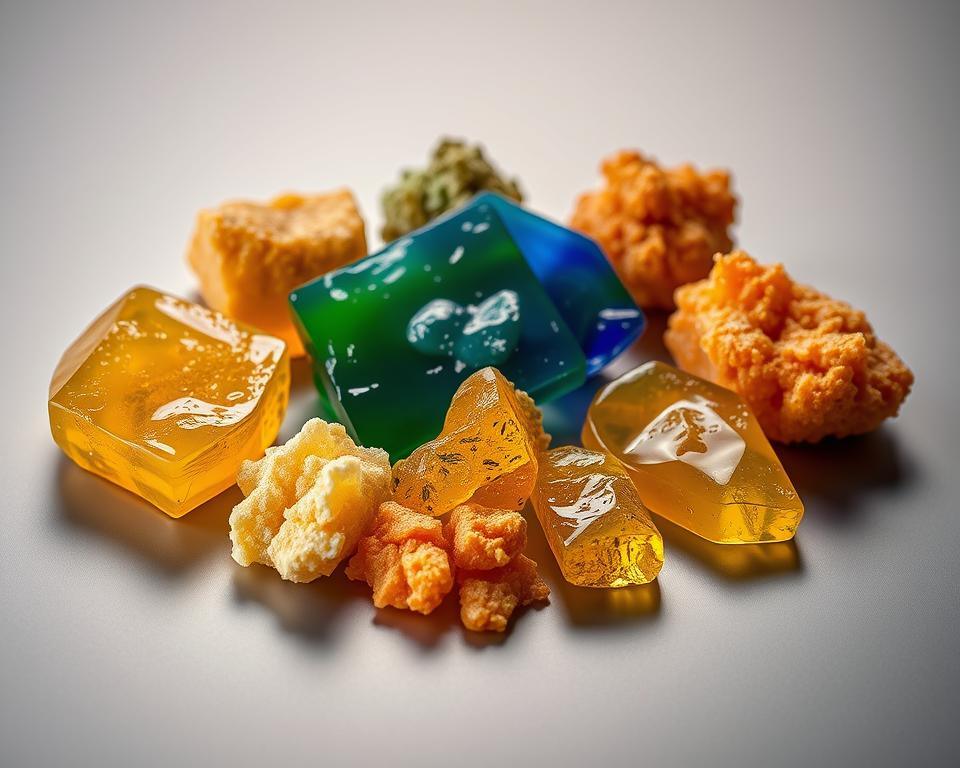Did you know cannabis concentrates can have up to 90% THC? This is much higher than the 10-25% found in traditional cannabis flower. Wax dabs have changed how people enjoy cannabis, giving a strong and focused experience.

Cannabis concentrates are made through advanced extraction methods. These methods turn raw plant material into very potent products. Wax dabs are a favorite because of their varied textures and high levels of cannabinoids.
What are Wax Dabs: Properties and Characteristics
Wax dabs are a complex and fascinating part of the cannabis world. They pack the most important parts of the cannabis plant into a potent extract. Knowing about their chemical makeup helps us see the differences between various wax dab types.

Chemical Composition of Cannabis Concentrates
Cannabis concentrates are made up of many complex chemicals. The main parts are cannabinoids and terpenes. These decide how the concentrate will affect you and what it tastes like. The key components are:
- THC (Tetrahydrocannabinol)
- CBD (Cannabidiol)
- Terpenes
- Flavonoids
The Role of Terpenes and Cannabinoids
Terpenes and cannabinoids work together to create the "entourage effect". Cannabinoids give you the high and health benefits, while terpenes add unique flavors and extra benefits. Each strain's terpene mix changes its smell, taste, and effects.
Extraction Methods and Their Impact
How you extract the wax dab changes its quality and what it's like. Common ways to extract include:
- Butane Hash Oil (BHO) Solvent-based extraction
- CO2 Solvent-based extraction
- Ethanol extraction
- Rosin press Solventless technique
Each method affects how much of the good stuff you get. It changes the wax dab's strength, taste, and overall feel.
Dab vs Wax: Is Dab and Wax the Same Thing?
Many people get confused about "dab" and "wax" in cannabis concentrates. While they're often used together, they're not the same. Let's look at the main differences to clear up any confusion.

Dabs and wax are related in the cannabis world. Wax is a type of concentrate that you can dab. Think of wax as the material and dabbing as the way to use it. The main features are:
- Soft, opaque texture like ear wax
- High THC content (usually 60-80%)
- Made with solvents like butane or CO2
The main difference is how you use them. Dabbing is heating a small amount of concentrate (like wax) and inhaling the vapor. Wax is just one type of concentrate you can dab.
Our cannabis community has created advanced ways to make and use these strong extracts. Wax is still popular because it's easy to handle and has strong effects. Knowing these differences helps people make better choices about their cannabis.
Explore the Different Types of Wax Dabs and What Does a Dab Look Like
When you start exploring cannabis extracts, you enter a world full of variety. Wax dabs are a key part of this world. Each type has its own special qualities, making them perfect for different tastes and ways of using them.

Knowing about the different wax dabs can help you pick the best one for you. There are several common types:
Solvent Extraction Methods:
- Live Resin: Extracted from fresh, frozen cannabis plants
- Shatter: Known for its glass-like, translucent appearance
- Budder: Characterized by a soft, butter-like consistency
- Sugar Wax: Featuring a granular, sugar-like texture
- Crumble: A dry, easily breakable concentrate
- Honeycomb: Resembling a honeycomb structure with a brittle texture
- THC Diamonds and Sauce: Crystalline structures with high potency
- Rick Simpson Oil, also known as RSO, is a full extract cannabis oil.
Solventless Extraction Methods
- Live Hash Rosin: Solventless extract using ice water method
- Ice Water Hash: High-quality bubble hash
-
kief, Charas Dry Sift: Traditional mechanical extraction method
Every wax dab offers a unique experience. This is because of how they're made and the cannabis used. The quality of these extracts depends on many things, like the plant, how it's extracted, and how it's processed.
Experienced users like to try different wax dabs. They look for the perfect texture, flavor, and strength. Whether you want a smooth budder or a brittle shatter, there's something for everyone.
Shatter vs. Budder: Key Differences and Uses
Cannabis concentrates come in many forms, with shatter and budder being favorites. They differ in how they look, how strong they are, and how you use them.

Consistency and Texture Comparison
Shatter and budder have different looks and feels. Shatter is clear and breaks into sharp pieces. Budder is soft and creamy, like butter.
- Shatter: Transparent, brittle consistency
- Budder: Opaque, smooth, and pliable
- Texture determines ease of handling and consumption
Potency and Purity Levels
Choosing a concentrate depends on how strong you want it. Shatter has more THC, usually 60-80%. Budder has less THC but tastes better because it keeps more terpenes.
Storage Requirements
Storing your concentrates right keeps them good. Keep shatter and budder in cool, dark places in non-stick containers. Silicone or glass is best to keep them strong and fresh.
- Keep away from direct light
- Maintain consistent temperature
- Use airtight containers
Live Resin and Sugar Wax Characteristics
Cannabis concentrates have changed a lot. Live resin and sugar wax are two new ways to enjoy cannabis. Live resin uses fresh, frozen plants right after they're picked. This keeps the plant's original smell and taste very well.

Live resin is known for its strong flavor and smell. It captures the plant's oils when they're at their freshest. This makes it taste and smell better than other cannabis products. People who love cannabis enjoy live resin for its true plant taste.
- Unique extraction method using frozen cannabis plants
- Highest preservation of original terpene profile
- More intense flavor and aroma compared to other concentrates
Sugar wax is different because of its grainy texture. It's made in a special way that makes it look and feel unique. The way it's made gives it a special feel when you use it.
- Granular, crumbly texture
- Distinct crystalline appearance
- Produced using specialized extraction techniques
Knowing the differences between live resin and sugar wax helps you choose what you like best. Whether you want something with a lot of flavor or a special texture, these cannabis products have something for everyone.
THCa Diamonds and Terpene Sauce
THCA diamonds are the best. They’re potent and pretty. That’s because of the special extraction method that pulls out pure THCA from terpene sauce.
“An arrangement of THCA diamonds and terpene sauce on a black background. The diamonds sparkle in the light, showing off their crystalline structure, while the sauce flows around them in amber and gold tones. Soft shadows and a bit of glow off the surface.”

Diamonds and sauce lets you control your cannabis use. It’s isolating THCA crystals from terpene sauce. It’s potent and delicious.
- THCA diamonds 90-99% cannabinoid content
- Terpene sauce rich flavor profiles and additional benefits
- Allows for precise dosing and personal use
To dab THCa diamonds and sauce you need a right erig. Low temp dabs preserve terpenes and deliver strong effects. Store in cool dark places to keep quality and potency.
Crumble and Honeycomb: Texture and Application
Cannabis concentrates like crumble and honeycomb offer unique experiences. They have intense flavors and strong dabbing methods. These are favorites among experienced users.

Production Techniques
Making crumble and honeycomb needs special extraction methods. These methods create their unique textures. Here's how:
- Crumble is made with lower heat purging methods
- Honeycomb needs precise vacuum oven techniques
- Removing solvents is key to their texture
Handling and Consumption Methods
Handling these concentrates right is important. You need clean dab tools and the right storage temperatures. This keeps them in top shape.
- Use ceramic or titanium dabbing tools
- Heat surfaces to the best temperatures
- Store in cool, dark places
Preservation Guidelines
Keeping your crumble and honeycomb concentrates fresh is crucial. Use airtight containers and keep them in controlled environments. This helps keep their potency and flavor.
Dabbing Essentials
When dabbing you need to have the right tools for the job. Your dab rig is the key to enjoying top shelf concentrates. Choosing the right gear makes all the difference in flavor, potency and fun.
At the core of your dabbing kit you’ll need a few key pieces. A good dab rig is a must, Empire Glassworks or MJ Arsenal are great options. Nails made of quartz, titanium or ceramic all hold heat well. Your dabber tool should be strong and accurate so you can handle your concentrates with care.
Temperature control is key in dabbing. Get a good torch or e-nail for consistent heat. Carb caps help control airflow and get the most out of each dab. Clean your gear often so it works well and doesn’t taste bad or cause bad effects.

